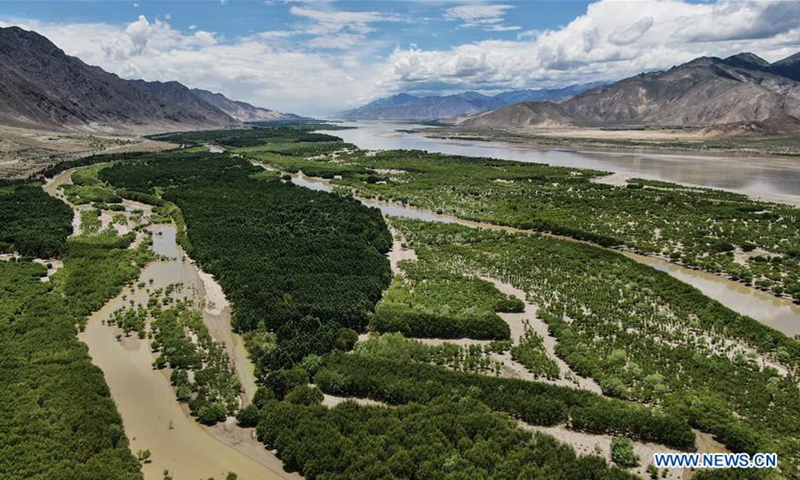China to build historic Yarlung Zangbo River hydropower project in Tibet
By Shan Jie and Lin Xiaoyi Source: Global Times Published: 2020/11/29 20:19:33

Aerial photo taken on June 27, 2020 shows a shelter forest along the Yarlung Zangbo River in Shannan, southwest China's Tibet Autonomous Region. (Xinhua/Jigme Dorje)
China will build a hydropower project on the Yarlung Zangbo River, one of the major waters in Asia that also passes through India and Bangladesh, and the head of the involved company said that the project could serve to maintain water resources and domestic security.
China will "implement hydropower exploitation in the downstream of the Yarlung Zangbo River," and this was clearly put forward in the proposals for formulating the country's 14th Five-Year Plan (2021-25) and its long-term goals through 2035 made by the Central Committee of the Communist Party of China, Yan Zhiyong, chairman of the Power Construction Corp of China, or POWERCHINA, said at a conference on Thursday, according to an article on the WeChat account of the Central Committee of the Communist Youth League of China on Sunday.
"There is no parallel in history… it will be a historic opportunity for the Chinese hydropower industry," Yan told a conference to celebrate the 40th anniversary of the founding of the China Society for Hydropower Engineering.
According to the report, the mainstream of the Yarlung Zangbo River has the richest water resources in Southwest China's Tibet Autonomous Region, about 80 million kilowatt hours (kWh), while the 50-kilometer section of the Yarlung Zangbo Grand Canyon has 70 million kWh that could be developed with a 2,000-meter drop, which equals more than three Three Gorges power stations.
Tibet has about 200 million kWh of water resources, accounting for 30 percent of the total in China.
Yan said that the hydropower exploitation of the Yarlung Zangbo River downstream is more than a hydropower project. It is also meaningful for the environment, national security, living standards, energy and international cooperation.
According to Yan, the 60 million kWh hydropower exploitation at the downstream of the Yarlung Zangbo River could provide 300 billion kWh of clean, renewable and zero-carbon electricity annually. The project will play a significant role in realizing China's goal of reaching a carbon emissions peak before 2030 and carbon neutrality in 2060.
"It is a project for national security, including water resources and domestic security," the POWERCHINA chairman said, noting that the project will also smooth cooperation with South Asia.
The hydropower station could generate income of 20 billion yuan ($3 billion) annually for the Tibet Autonomous Region, he said.
POWERCHINA on October 16 signed a strategic cooperation agreement covering the 14th Five-Year Plan with the Tibet Autonomous Region and held meetings with the region's Party secretary Wu Yingjie and regional government chairman Qizhala, according to POWERCHINA's official website.
Lin Boqiang, director of the China Center for Energy Economics Research at Xiamen University, told the Global Times that with the construction experience of the Three Gorges Hydropower Station, the Baihetan Hydropower Station and other huge hydropower projects in which many world-class technological and planning problems were solved, China has developed mature and advanced operational capacities for complex issues in building hydropower stations such as technology standards and civilian resettlement and relocation.
The Three Gorges Hydropower Station project eventually relocated 1.4 million people, according to the Xinhua News Agency. In Southwest China's Sichuan and Yunnan provinces, a total of 89,021 people will be resettled to build the Baihetan Hydropower Station.
Lin stressed that hydropower projects on cross-border rivers cannot be developed without communication and cooperation between upstream and downstream countries. The hydropower development of the Yarlung Zangbo River will provide more opportunities for cooperation between China and South Asian countries, which can learn from the mode of the Lancang-Mekong cooperation mechanism, through dialogue and establishment of cooperation mechanisms to promote the comprehensive utilization and development of water resources.
Speculations about China planning to build a "super hydropower station" in Medog county, where the Yarlung Zangbo Grand Canyon is located, have circulated for years. Medog, with a population of about 14,000, was China's last county to be connected to the outside world with a highway.
Posted in: SOCIETY